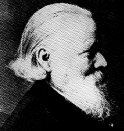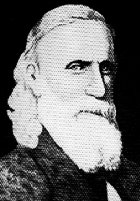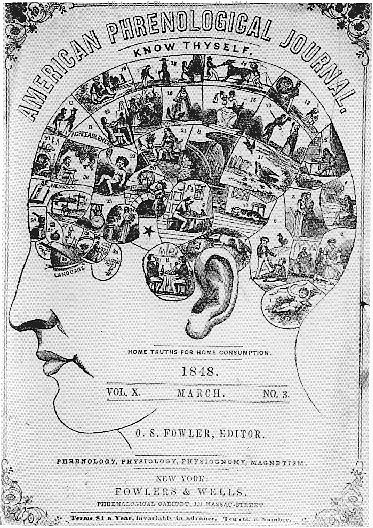The foremost American phrenologists. The Fowler brothers began reading heads in New York in the 1840s. Joined by Samuel R. Wells (1820-75) in 1844 their publishing industry churned out vast quantities of phrenological periodicals, pamphlets and books. Their phrenology was derived entirely from the Combean brand.

Lorenzo Niles Fowler (1811-96)
Lorenzo Niles Fowler was the son of New York farmers who grew
up working on the farm and was educated at the district school. He later studied
to become a clergyman at Amherst Academy. By the age of sixteen he had helped
to found a student temperance society. In 1834 his elder brother Orson Squire
Fowler (1809-1887)  became
a convert to phrenology while a student at Amerherst College New York from
fellow students and from reading J.G. Spurzheim
and George Combe. Lorenzo soon followed his brother.
Before long they were reading heads and offering lectures on the subject assisted
by their sister Charlotte. They immediately found the new science of the mind
profitable and eventually gave up on the idea of becoming clergymen. In 1836
Lorenzo set up a phrenological establishment in New York and in 1838 Orson
set up a similar establishment in Philadelphia. Here in the same year they
founded the American Phrenological Journal and Miscellany
became
a convert to phrenology while a student at Amerherst College New York from
fellow students and from reading J.G. Spurzheim
and George Combe. Lorenzo soon followed his brother.
Before long they were reading heads and offering lectures on the subject assisted
by their sister Charlotte. They immediately found the new science of the mind
profitable and eventually gave up on the idea of becoming clergymen. In 1836
Lorenzo set up a phrenological establishment in New York and in 1838 Orson
set up a similar establishment in Philadelphia. Here in the same year they
founded the American Phrenological Journal and Miscellany  which
would continue until 1911. Lorenzo was particularly interested in the casting
of plaster phrenological busts. With a phrenological office to serve as a
museum, they began to collect copies of the collections of the Edinburgh Phrenological
Society and James
De Ville in London. The Fowlers expanded into publishing reprints of the
phrenological greats such as Spurzheim and Combe as well as their own works.
By the 1840s they had one of the largest publishing concerns in New York.
which
would continue until 1911. Lorenzo was particularly interested in the casting
of plaster phrenological busts. With a phrenological office to serve as a
museum, they began to collect copies of the collections of the Edinburgh Phrenological
Society and James
De Ville in London. The Fowlers expanded into publishing reprints of the
phrenological greats such as Spurzheim and Combe as well as their own works.
By the 1840s they had one of the largest publishing concerns in New York.
Lorenzo travelled to England in 1860 with his wife Lydia and daughter Jessie and partner Samuel Wells (1820-75). Fowler lectured widely in Britain and his tours led to the creation of new phrenological societies just as earlier lecturers like Spurzheim and Combe had inspired similar societies decades before. Fowler lectured at the International Exhibition of 1862 and then returned briefly to New York. He then emigrated to Britain to enjoy the rich phrenological pickings and founded the Fowler Institute, Ludgate Circus, London, in 1863. Here he and his family and employees gave practical instruction on phrenology, provided readings and character analyses and offered weekly courses on practical phrenology. The also sold the ubiquitous phrenological literature and phrenological busts. The Institute had its own circulating and reference library and a museum of skulls and casts. In the 1870s Fowler returned to the British lecture circuit and was particularly popular in the Midlands. In 1886 he established and presided over the British Phrenological Association which endured until 1967.
The Fowlers phrenology was entirely a derivation of the British phrenology formed by Spurzheim and the Combe's. Of course in the history of ideas there are no real copies, merely more or less similar imitations. Therefore although the Fowler's phrenology was essentially borrowed wholesale and their doctrines of health, temperance, practical ethics and morality were virtually a transcript of Combe's Constitution of man (1828), the Fowler's rendition of these inspirations was at the same time something new. To the older phrenologists of Britain, Fowler phrenology was a vulgarisation. George Combe avoided mentioning or meeting the Fowlers during his successful lecture tour of America (1838-1840). The Fowlers were professedly practical phrenologists who read thousands of heads for fees, lectured widely and also wrote extensively on the subject. Amongst the well-known heads read by Lorenzo were Walt Whitman, Mark Twain and Clara Barton.
In addition to phrenology Lorenzo supported a number of unorthodox and reformist innovations including hydropathy and phreno-mesmerism. Lorenzo co-founded and was for a time vice-president of the American Hydropathic Association. He also mesmerized patients before surgical operations. Lorenzo Fowler returned to America for a visit in 1896 where he died of a stroke 2 September 1896.
BIBLIOGRAPHY
The Principles of Phrenology and Physiology applied to Man's Social Relations; together with an Analysis of the Domestic Feelings (1842).
Marriage: Its History and Ceremonies with a Phrenological and Physiological Exposition of the Functions and Qualifications for Happy Marriages (1847).
Lectures on Man, as Explained by Phrenology, Physiology, Physiognomy, and Ethnology (1864).
The Phrenological and Physiological Register, adapted to the use of Phrenologists for Recording Charts of Character [1864].
New Illustrated Self-Instructor in Phrenology and Physiology (1868).
How to Learn Phrenology with Hints as to the Study of Character (1881).
Mental Science as Explained by Phrenology. Revised and Enlarged (1896).
Phrenological Dictionary [1894].
Further Reading
Boase, Frederic, ed., Modern English Biography, 6 vols (1965).
Cooter, R., The cultural meaning of popular science: Phrenology and the Organization of Consent in nineteenth-century Britain (1984).
Cooter, R., Phrenology in the British Isles: An Annotated, Historical Bibliography and Index (1989).
Stern, M., Heads & Headlines: The Phrenological Fowlers (1971).

Examining room at the Fowler and Wells phrenological museum, New York, 1860.
Reproductions of this bust c. 1880s by L.N. Fowler, are sold as souvenirs today.
© John van Wyhe 1999-2011. Materials on this website may not be reproduced without permission except for use in teaching or non-published presentations, papers/theses.